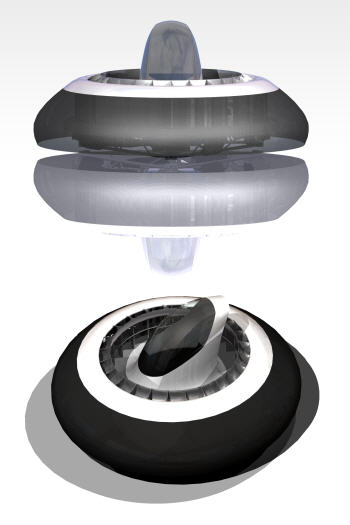A different 'spin' on flying cars

A company in Australia is developing a flight technology that allows for compact Vertical Take-Off and Landing (VTOL) using a type of fan system to move air that is commonly found in central heating/cooling systems.

Entecho's Hoverpod
Entecho is using a proprietary centrifugal fan that allows for the creation of an extremely compact craft with VTOL capabilities and high lifting efficiencies. The company currently has two VTOL platforms; the Hoverpod, a manned Personal Aerial Vehicle (PAV) and the Mupod, a micro Unmanned Aerial Vehicle (UAV).
As Gizmag points out, the "cylindrical fan-forced flying saucer" is quite different from PAV concepts we've seen lately like Terrafugia's folding-wing plane or Moller International's Skycar.
"Entecho's core IP is an odd enclosed-rotor flight technology that requires a disc-shaped aircraft with passengers or payload in the center...Totally VTOL and with a small footprint, perhaps the Entecho Hoverpod might deliver as a practical and affordable personal flight solution."
The manned vehicle is about 5 feet in diameter and can travel up to 75 mph, seat 3 passengers, and is currently designed to fly at an altitude of only around 5 feet--still greater than a conventional hovercraft, allowing it to pass over any terrain.
The company says that the Hoverpod enjoys the freedom to tilt and develop translational g-forces in any direction. "This omni-directional ability makes the Hoverpod further unique compared to conventional recreational vehicles."
Sounds like a fun ride, now let's take a closer look at how the fan technology works. Entecho's centrifugal fan moves air radially from the center to its outside. Lift is generated as the radial flow from the fan is directed downward by a skirt that allows easy directional control. The skirt is an airtight flexible membrane which wraps circularly around the body of the craft and is located downstream of the rotor. The simple design makes it so that the blades are not exposed and they move reasonably slowly, both factors which help to increase safety. The result is a new type of aerial craft that they call CAS, or Compact Aerial Vehicle, that is stable and easy to fly using a joystick controller.
The company, founded and ran by Kim Shlunke, a 25-year industry veteran who was previously the CEO of Orbital Engine Corp, hasn't announced manned test flights as of yet, but from all accounts it looks like they're just about ready.